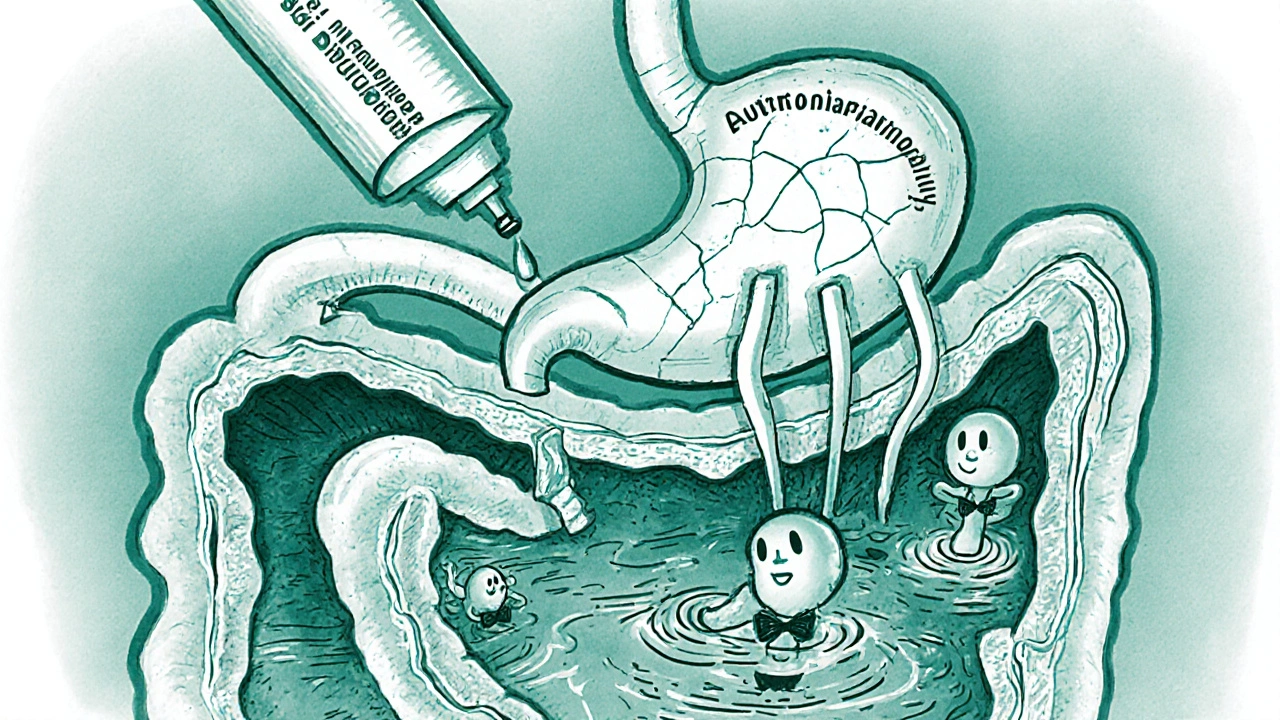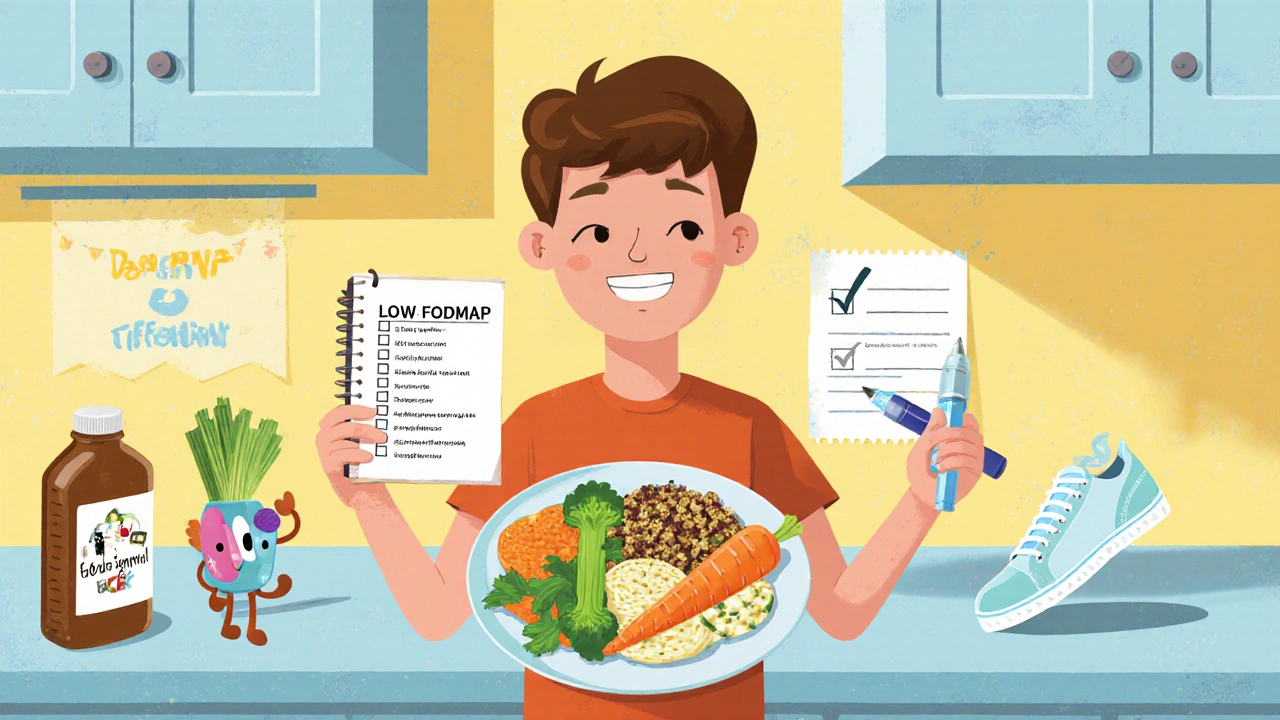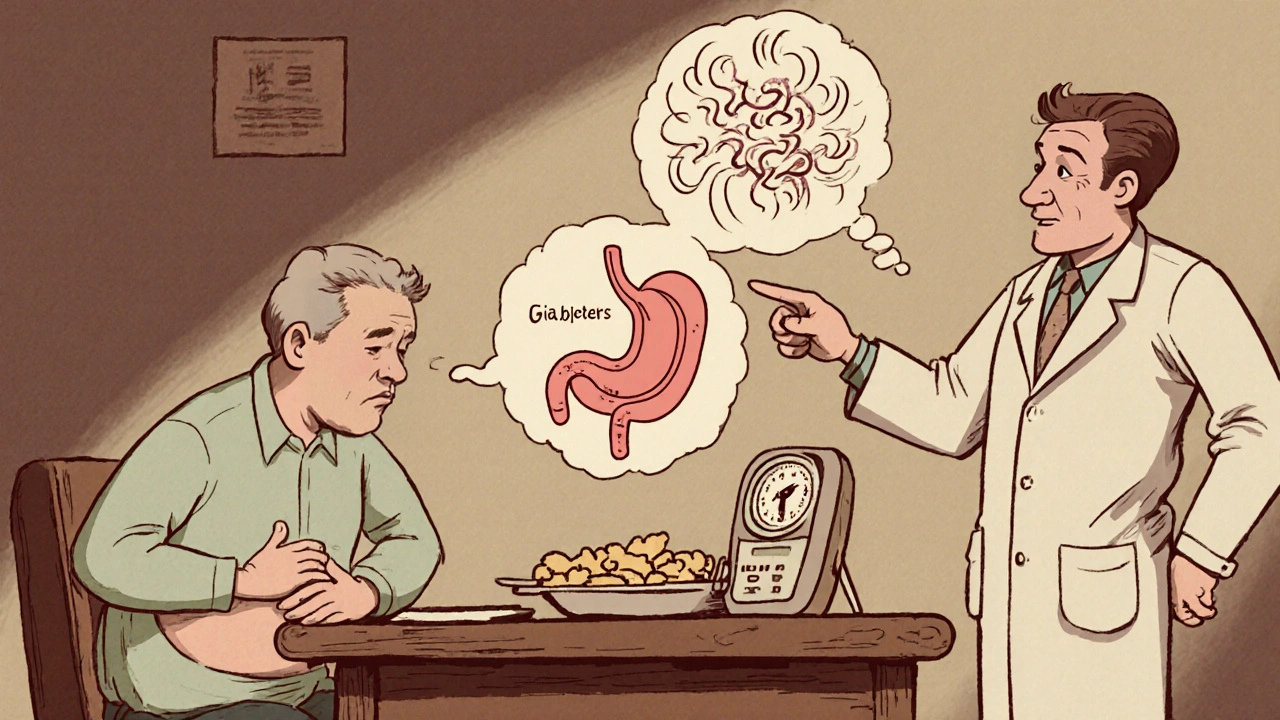Diabetes Abdominal Distension Symptom Checker
Step 1: Describe your symptoms
Select all symptoms that apply to you. The more details you provide, the more accurate the results will be.
Key Takeaways
- Diabetes can slow stomach emptying, cause bacterial overgrowth, and lead to high blood‑sugar‑related bloating.
- Gastroparesis, SIBO, medication side‑effects and poor glucose control are the top culprits.
- Tracking meals, adjusting insulin, eating low‑FODMAP foods and adding probiotics often bring relief.
- Seek medical help if you notice sudden weight loss, vomiting, severe pain or persistent nausea.
- Regular HbA1c checks and a good fiber plan keep both sugar levels and gut comfort in check.
When you live with diabetes, a swollen belly can feel like a mystery you’ll never solve. The good news is that most of the time the cause is something you can identify and treat. Below we break down why abdominal distension shows up, which diabetes‑related factors matter most, and what simple steps can keep your gut feeling normal again.
What Is Abdominal Distension?
Abdominal distension is a condition where the stomach area feels unusually full, tight or visibly enlarged. It’s often described as a “bloat” that doesn’t go away after a normal meal. The sensation can range from mild discomfort to painful pressure, and it may be accompanied by visible swelling.
Distension isn’t a disease itself; it’s a clue that something in the digestive tract is out of balance. Common triggers include excess gas, fluid buildup, slowed motility, and inflammation.
Why Diabetes Matters for Your Gut
Diabetes mellitus is more than high blood sugar-it’s a systemic condition that affects nerves, blood vessels and the muscles that move food through your intestines. When blood glucose spikes repeatedly, nerves in the stomach wall can become damaged (a condition called autonomic neuropathy). This damage slows the stomach’s ability to contract and push food onward, leading to a feeling of fullness and gas buildup.
On top of nerve damage, high glucose can alter the balance of good and bad bacteria in the intestines, creating an environment where gas‑producing microbes thrive.
Top Diabetes‑Related Causes of Abdominal Distension
Below are the most frequent reasons why people with diabetes experience bloating and a swollen belly.
- Gastroparesis - delayed stomach emptying caused by nerve damage. Food sits in the stomach longer, fermenting and releasing gas.
- Small intestinal bacterial overgrowth (SIBO) - an excess of bacteria in the small intestine that produce excess gas when they break down carbohydrates.
- Chronic hyperglycemia - high blood sugar pulls water into the gut lumen, leading to swelling and a feeling of “fullness”.
- Side‑effects of insulin therapy - rapid changes in glucose can cause rapid shifts in gut motility, sometimes resulting in bloating.
- Medications such as metformin, GLP‑1 agonists or certain antibiotics that alter gut flora or slow intestinal transit.

Spotting Red‑Flag Symptoms
While most bloating episodes are benign, a few signs mean you need professional care right away:
- Unexplained weight loss or persistent vomiting.
- Severe, cramp‑like pain that doesn’t ease with a walk.
- Sudden swelling that’s hard to press out (possible ascites).
- Blood in stool or black, tarry stools.
- Persistent nausea despite medication adjustments.
If you notice any of these, call your health provider. Early diagnosis can prevent complications like malnutrition or severe gastroparesis.
Managing the Discomfort: Diet and Lifestyle Hacks
Most people find relief by tweaking what they eat and how they control their sugar levels.
1. Keep a food‑symptom journal. Write down what you eat, portion size, blood‑glucose reading, and any bloating you feel. Patterns often emerge-maybe dairy, beans or high‑FODMAP foods are the culprits.
2. Choose low‑FODMAP options. Foods low in fermentable oligosaccharides, disaccharides, monosaccharides and polyols are easier on the gut. Good choices include carrots, zucchini, oatmeal, quinoa, and ripe bananas.
3. Add soluble fiber gradually. Dietary fiber helps regulate bowel movements and can improve gastroparesis symptoms if you increase it slowly (10‑15g per day) and pair it with plenty of water.
4. Try probiotics. Certain strains-Lactobacillus plantarum and Bifidobacterium lactis-have shown benefits for SIBO and general bloating. A daily capsule of 10‑20billion CFU is a common starting point.
5. Control blood sugar tightly. Keeping your HbA1c under 7% (or the target set by your doctor) reduces hyperglycemia‑related fluid shifts that cause swelling.
6. Move after meals. A gentle 10‑minute walk helps stimulate gastric emptying and reduces gas buildup.
7. Review medications. If metformin is a trigger, talk to your clinician about an extended‑release formulation or a lower dose.
Medication and Insulin Adjustments
When bloating persists despite diet tweaks, reviewing your medication regimen is crucial.
- Insulin timing. Rapid‑acting insulin taken right before a meal can cause a sudden drop in glucose, leading to a short‑term slowdown of gut motility. Splitting the dose or using a basal‑bolus approach may smooth the curve.
- GLP‑1 agonists. These drugs delay gastric emptying on purpose to lower post‑meal spikes, but for some people the delay becomes excessive. Dose reduction or a switch to a different class may help.
Always discuss any changes with your diabetes care team; abrupt alterations can affect blood‑sugar control.

Quick Reference: Common Causes vs. Typical Management
| Cause | Primary Mechanism | Key Symptoms | First‑Line Management |
|---|---|---|---|
| Gastroparesis | Delayed gastric emptying due to nerve damage | Early satiety, nausea, frequent belching | Low‑fat, low‑fiber meals; pro‑kinetic meds (e.g., metoclopramide); small frequent meals |
| SIBO | Excess bacterial fermentation in the small intestine | Bloating, gas, diarrhea or constipation | Low‑FODMAP diet; targeted antibiotics (rifaximin); probiotics |
| Hyperglycemia‑induced fluid shift | Osmotic water movement into intestinal lumen | Swollen abdomen, thirst, polyuria | Intensify glucose monitoring; adjust insulin; hydrate appropriately |
| Medication side‑effects (metformin, GLP‑1) | Altered gut motility or increased gas production | Flatulence, mild cramping | Switch formulation, dose split, consider alternatives |
When to Seek Professional Help
If you try diet, lifestyle, and medication tweaks for two weeks and the belly still feels tight, schedule a visit. Your clinician may order:
- Gastric emptying study (scintigraphy) to confirm gastroparesis.
- Breath test for SIBO.
- Abdominal ultrasound or CT if structural problems are suspected.
Early detection lets you get targeted treatments-like pro‑kinetic drugs or specific antibiotics-before the discomfort worsens.
Frequently Asked Questions
Can high blood sugar alone cause a bloated belly?
Yes. When glucose stays high, it pulls water into the intestines, expanding the gut lumen and creating a sensation of fullness. Tight glucose control often reduces this swelling.
Is it safe to take probiotics while on insulin?
Generally, yes. Probiotics don’t interfere with insulin’s action. They can actually improve gut health and may lower the frequency of bloating. Always pick a reputable brand and discuss any new supplement with your care team.
What foods should I avoid to reduce abdominal distension?
Limit beans, lentils, onions, broccoli, cabbage, carbonated drinks, and artificial sweeteners. Foods high in fructose or sorbitol are classic gas producers for many people with diabetes.
Can exercise really help my stomach empty faster?
A short walk (5‑10 minutes) after meals stimulates the vagus nerve, which can speed up gastric emptying. Even light yoga poses like the seated twist have shown modest benefits.
When is a gastric emptying scan recommended?
If you have persistent early satiety, nausea, and visible bloating despite diet changes, doctors often order a scintigraphy test. It measures how quickly a radioactive meal leaves the stomach and helps confirm gastroparesis.
Abdominal distension isn’t something you have to live with forever. By understanding how diabetes impacts your gut, spotting the right warning signs, and applying targeted diet and medication tweaks, you can reclaim a flatter, more comfortable belly. Keep a symptom log, stay on top of your glucose numbers, and don’t hesitate to bring persistent bloating to your health‑care team’s attention.

Val Vaden
Looks like you just copied a medical textbook, huh? 😒
lalitha vadlamani
One must commend the author for attempting to demystify a serious condition, yet the prose feels somewhat lacking in the gravitas such a topic deserves. In the realm of health literacy, clarity paired with moral responsibility is paramount. It is incumbent upon us to present information that does not merely inform but also empowers the reader to make judicious choices about their well‑being. Moreover, the omission of cultural considerations may inadvertently marginalize populations for whom dietary adjustments are not merely preferences but necessities dictated by socioeconomic constraints. Therefore, while the article provides a solid foundation, it ought to be expanded with a more discerning eye toward inclusivity and ethical stewardship of knowledge.
kirk lapan
Alright, let me break this down for the masses, because apparently the original author forgot to include the "how to actually fix this" part. First off, gastroparesis isn’t some exotic side‑effect you can ignore – it’s a real neurogastro disorder that slows your stomach like rush hour traffic in downtown LA. Second, if you’re constantly chowing down on high‑FODMAP foods, you’re basically feeding the bacteria that cause SIBO, and that’s a recipe for perpetual bloat. Third, the article never mentioned the importance of timing your insulin with low‑glycemic carbs – that’s a classic mistake that spikes your blood sugar and in turn pulls water into the gut, making you feel like a balloon. Fourth, metformin, while a lifesaver for many, can cause GI distress; the extended‑release form is often a better bet if you’re sensitive. Fifth, don’t forget to hydrate – water helps flush out excess electrolytes that contribute to swelling. Sixth, pro‑kinetic meds like metoclopramide can be a game‑changer, but they come with their own set of side‑effects, so consult your doc. Seventh, a low‑fat diet really does help because fat delays gastric emptying, which is the last thing you need. Eighth, try a structured low‑FODMAP trial for at least six weeks before giving up; many people bail too early and miss the benefits. Ninth, don’t just rely on probiotics; specific strains like Bifidobacterium longum have better evidence for SIBO than generic blends. Tenth, keep a detailed log – not just of meals but also of glucose readings and bowel movements; patterns will emerge. Eleventh, consider a breath test if you suspect SIBO, because treating with antibiotics without confirmation is like throwing darts blindfolded. Twelfth, add some gentle yoga poses after meals – the seated twist actually stimulates the vagus nerve and can improve motility. Thirteenth, if you’re on GLP‑1 agonists, ask about dose adjustments; too high a dose can overly delay stomach emptying. Fourteenth, watch out for hidden carbs in sauces and dressings – they can sabotage your glucose control and thus your gut. Fifteenth, finally, don’t ignore red‑flag symptoms like unexplained weight loss or vomiting; those are signs you need immediate medical evaluation. In short, the article scratches the surface; you need a holistic, data‑driven approach to truly conquer diabetic bloating.
Landmark Apostolic Church
Imagine your stomach as a quiet lake; diabetes can turn it into a stormy sea, swirling with nerves and microbes. The key is to find calm amidst the turbulence.
Matthew Moss
It is absolutely unacceptable that so many disregard simple dietary measures when faced with such a critical health issue. One must act with patriotic duty to one’s own well‑being.
Antonio Estrada
I appreciate the philosophical angle above. Adding a practical tip: try a short post‑meal walk of five minutes; it often eases the sense of fullness.
Andy Jones
Well, this article could use a grammar check – "high‑blood‑sugar‑related" should be hyphenated correctly, and "low‑FODMAP" needs consistent capitalization. Also, "medication side‑effects" is redundant; just say "medication side effects".
Kevin Huckaby
Oh really? You think a simple list is enough? 🤔 Let’s sprinkle some color: Imagine your gut as a wild party 🎉 – if you invite too many carb‑guests, they’ll dance and produce gas like nobody’s watching! Cut the carbs, dim the lights, and let the probiotics be the DJ. 😎
Brandon McInnis
Honestly, this post feels like a roller coaster of information – thrilling at times, dizzy at others. Still, kudos for tackling a topic that many shy away from.
Scott Swanson
Sure, roller coasters are fun, but we’re dealing with real gut distress. If you’re truly committed, try the ‘feedback loop’ – log meals, glucose, and bloating, then adjust. It’s the only way to turn drama into data.
Allison Marruffo
Great overview! For anyone feeling overwhelmed, start with one change at a time – perhaps swapping soda for water and seeing how that impacts bloating.
Ian Frith
From a clinical perspective, the interplay between hyperglycemia and intestinal motility is often underappreciated. When glucose spikes, osmotic water shifts into the lumen, magnifying distension. Moreover, chronic autonomic neuropathy diminishes the coordinated peristaltic waves, leading to retained gastric contents that ferment and release gas. A systematic approach-tight glycemic control, low‑FODMAP diet, and judicious use of pro‑kinetics-can mitigate these mechanisms. Remember, each patient’s microbiome is unique; tailoring probiotic strains may offer additional benefit.
Beauty & Nail Care dublin2
🧐 Did you know the government *actually* hides the truth about gut‑brain connections? 🤐 They don’t want you to know that a simple diet tweak can free you from the system’s control! 💥
Derrick Blount
Attention: the article fails to address, fundamentally, the pathophysiology-specifically, the role of interstitial cells of Cajal; moreover, the recommendation to “move after meals” lacks citation!!!
luemba leonardo brás kali
Indeed, the interstitial cells of Cajal act as pacemakers for gastrointestinal motility. Including that detail would enhance the article’s scientific rigor.
Corey McGhie
Nice work compiling all that info-though if you really wanted to help folks, a quick‑reference chart at the top would save a lot of scrolling. Just saying.